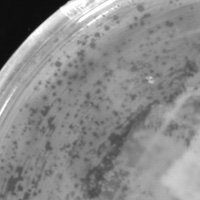Streptomyces phage Mudwoot
Add or modify phage thumbnail images to appear at the top of this page.
Know something about this phage that we don't? Modify its data.
| Detailed Information for Phage Mudwoot | |
| Discovery Information | |
| Isolation Host | Streptomyces venezuelae ATCC 10712 |
| Found By | Kemberly Medrano Sanchez |
| Year Found | 2024 |
| Location Found | Denton, TX United States |
| Finding Institution | University of North Texas |
| Program | Science Education Alliance-Phage Hunters Advancing Genomics and Evolutionary Science |
| From enriched soil sample? | Yes |
| Isolation Temperature | 30°C |
| GPS Coordinates | 33.209459 N, 97.146622 W Map |
| Discovery Notes | On August 21, 2024, at precisely 12 p.m., I collected a sample of rich, humid soil from beneath the sprawling canopy of a large tree, located just outside Wooten and Mathew’s Hall in Denton, Texas. The weather was notably warm, hovering around 90°F, with a lingering 50% humidity, a clear sign of the recent rainfall. Equipped with a simple spoon, I carefully dug approximately 5 centimeters below the surface, where the soil was dark and dense with moisture. After gathering 5 to 6 generous scoops, I sealed the earthy sample into a plastic bag for further examination. |
| Naming Notes | The name for my phage was inspired by one of the halls near the spot where I collected the soil sample. I had two options: Mathew’s or Wooten, and I ultimately chose Wooten. From there, I blended the word “mud,” reflecting the earthy nature of the sample, with “Wooten,” which led to the creation of the name “Mudwoot.” |
| Sequencing Information | |
| Sequencing Complete? | No |
| Sequencing Facility | University of North Texas |
| Genome length (bp) | Unknown |
| Character of genome ends | Unknown |
| Fasta file available? | No |
| Characterization | |
| Cluster | Unclustered |
| Subcluster | -- |
| Lysogeny Notes | The lysogeny experiment showed highly positive results. I had a titer of 4×10⁸ pfu/mL, which indicates a strong concentration of infectious phage particles. The DNA yield was also high, with a concentration of 103.1 ng/µL, showing successful extraction and purification of the phage genome. These results suggest optimal conditions for lysogeny and efficient phage-host interaction. Both the high titer and DNA concentration make this phage a strong candidate for further experiments like sequencing or molecular analysis. |
| Annotating Institution | Unknown or unassigned |
| Annotation Status | Not sequenced |
| Plaque Notes | A bacteriophage plaque is a window into the silent battles waged on a microscopic scale, where the boundaries of life and destruction blur. Typically, these plaques are small, measuring between 0.5 and 4 millimeters in diameter, with a near-perfect circular shape that hints at the uniform spread of viral infection. Their clarity can evoke intrigue—some are crystalline and entirely transparent, like a drop of water on glass, indicating thorough bacterial lysis. Others are faintly opaque, as though a veil of survivors lingers within the phage’s path. The edges can be razor-sharp, resembling the precision of a drawn line, or gently feathered, as if the phage’s influence faded gradually. For instance, a fast-acting lytic phage might leave behind a clear and sharp plaque, while a temperate phage might create softer, cloudy halos that tell the story of coexistence rather than annihilation. |
| Morphotype | Myoviridae |
| Has been Phamerated? | No |
| Publication Info | |
| Uploaded to GenBank? | No |
| GenBank Accession | None yet |
| Refseq Number | None yet |
| Archiving Info | |
| Archiving status | Archived |
| Pitt Freezer Box# | 205 |
| Pitt Freezer Box Grid# | B3 |
| Available Files | |
| Plaque Picture | Download |
| Restriction Digest Picture | Download |
